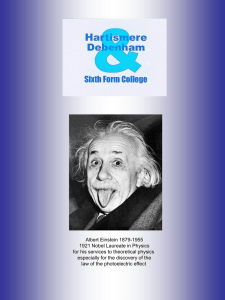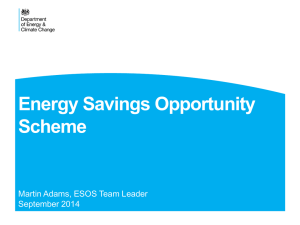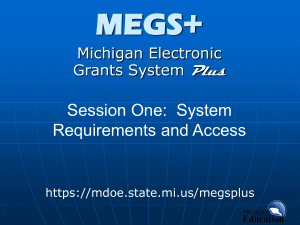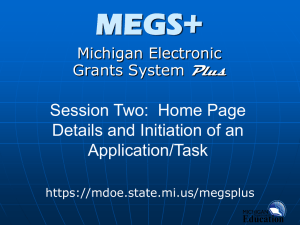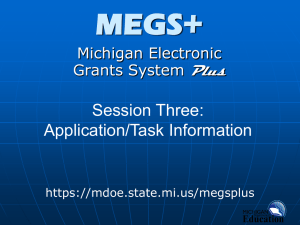systems engineering competencies and approaches
advertisement
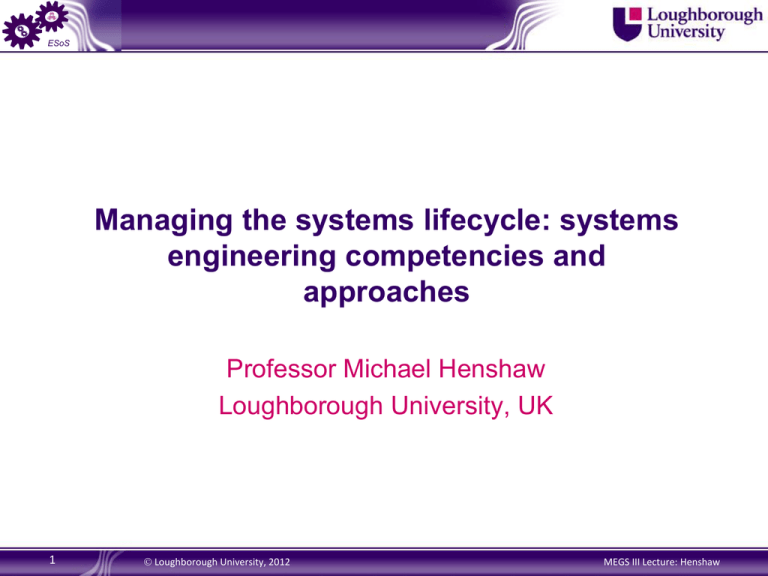
ESoS Managing the systems lifecycle: systems engineering competencies and approaches Professor Michael Henshaw Loughborough University, UK 1 Loughborough University, 2012 MEGS III Lecture: Henshaw ESoS Content Competency in Systems Engineering System lifecycles Standards ISO15288 the systems engineering lifecycle standard 2 Loughborough University, 2012 MEGS III Lecture: Henshaw ESoS Systems Thinking for Energy Negative Behavioural Change Bio Fuels for cars CO2 Increase Bio Fuel Production Example from Geoff Robinson, of Atkins, Keynote at ieee SoSE 2010 Food shortages Processing De forestation Systems Thinking: Understand complex problems Explore wider set of options 3 Loughborough University, 2012 MEGS III Lecture: Henshaw ESoS INCOSE Competency Framework Systems Thinking Systems concepts Super system capability issues Enterprise and technology environment Holistic Lifecycle View Determine and manage stakeholder requirements Systems design Architectural design Concept generation Design for... Functional analysis Interface management Maintain design integrity Modelling and simulation Select preferred solution System robustness Systems integration and verification Validation Transition to operation Systems Engineering Management Concurrent engineering Enterprise integration Integration of specialisms Lifecycle process definition Planning, monitoring and controlling 4 Loughborough University, 2012 MEGS III Lecture: Henshaw ESoS Typical stages of lifecycle management Initiation Planning & Design Execution Monitoring & Control Closing 5 Loughborough University, 2012 MEGS III Lecture: Henshaw ESoS Holistic lifecycle view Whole life costs Maintaining performance, safety, security, etc. Retaining knowledge of the system Upgrades Risks over time Disposal Image: Hunt Emerson 6 Loughborough University, 2012 MEGS III Lecture: Henshaw ESoS A System Definition of a system A system is a construct or collection of different elements that together produce results not obtainable by the elements alone. The elements, or parts, can include people, hardware, software, facilities, policies, and documents; that is, all things required to produce systems-level results. ......... (Rechtin, 2000). INCOSE definition (first part) Image: AP 7 Loughborough University, 2012 MEGS III Lecture: Henshaw ESoS Systems Engineering and the Systems Life Cycle Standard Required by 1. Systems Eng. and systems thinking 1. Standards Mindset and approach for 2. System Life cycles Defines 3. System of interest Constrains Applies std. 5. Tailoring Requires Is an appropriate 4. ISO15288 -scope -structure -use illustrates 7. Limitations 8 Enables mgt of Loughborough University, 2012 6. Case studies MEGS III Lecture: Henshaw ESoS Standards - why they are important The need for standards and Systems Engineering 9 Loughborough University, 2012 MEGS III Lecture: Henshaw ESoS Standards: Benefits and Applicability Benefits 10 Safety Interoperability Quality Upgradeability Loughborough University, 2012 Applicability Business Trade Technical Engineering Finance Etc. MEGS III Lecture: Henshaw ESoS Application to project phases SAE DIN BSI Manufacture ASME IEC ASTM Design Operation ISO API – Application Programming Interface ASME - American Society of Mechanical Engineers ASTM – American Society for the Testing of Materials BSI - British Standards Institution DIN - Deutsches Institut für Normung eV IEC - International Electrotechnical Commission ISO - International Standards Organization ITU – International Telecommunications Union SAE - Society of Automotive Engineers 11 Loughborough University, 2012 ISO ITU Construction API ASME From ‘Why Standards are Important’, IHS Whitepaper, www.ihs.com MEGS III Lecture: Henshaw ESoS Compliance Regulation A regulation is a legal requirement and compliance is, therefore, compulsory. A regulation is usually developed by Government and specifies what must be done, but without specifying how it must be done. Code A code is a standard (developed by an appropriate body) and adopted by a Government entity. Compliance is compulsory. Standard A specification of best practice developed by experts and based on consensus. It is recognised by an appropriate standards development organisation. Compliance is voluntary. Based on ‘Why Standards are Important’, IHS Whitepaper, www.ihs.com 12 Loughborough University, 2012 MEGS III Lecture: Henshaw ESoS Part 4 – ISO 15288 Origin of ISO 15288 Application and characteristics of the standard Basic content of the standard 13 Loughborough University, 2012 MEGS III Lecture: Henshaw ESoS Origin of ISO 15288 Emerging Standards Systems context 1960 1970 Space systems Increasing complexity Complex manufacture 1980 Software Military and civilian std. in US Std. In EU Software std. 1990 2000 ISO 15288 (2002) 2010 ISO 15288 (2008) 14 Loughborough University, 2012 MEGS III Lecture: Henshaw ESoS Characteristics of 15288 (1) Product/service Although described as applicable to service systems, the language and approach is strongly product based Description Standard is a comprehensive list of processes for life cycle management, but none is specified in detail Cannot be used without tailoring High-tech. Organisations recognise the standard, but don’t usually seek rigid compliance 15 Loughborough University, 2012 MEGS III Lecture: Henshaw ESoS Characteristics of 15288 (2) Uses As an outline framework from which organisation engineering and project management processes may be derived As a checking procedure for extant processes Level of compliance can indicate areas for process improvement Compliance is seen as meritorious, but not essential 16 Loughborough University, 2012 MEGS III Lecture: Henshaw ESoS Significant INCOSE Publications based on 15288 INCOSE Handbook INCOSE 2010 systems engineering handbook, version 3.2. San Diego, CA, USA: International Council on Systems Engineering (INCOSE), INCOSE-TP-2003-002-03.2 INCOSE UK Systems Engineering Competency Framework INCOSE UK 2010 17 Loughborough University, 2012 MEGS III Lecture: Henshaw ESoS Application Enterprise Enduring Organisation Long term General across all projects Single project Project Enterprise Tailoring Short term Procedures : Processes General/high level – slowly changing Consistency Processes 18 Loughborough University, 2012 Specific/detailed – as & when required MEGS III Lecture: Henshaw ESoS Generic Lifecycle Concept stage Development stage Production stage Utilisation stage Support stage Retirement stage A system progresses through specific stages during its life In reality stages overlap Enabling systems are required at each stage All stages should be considered at design time and lifecycle features incorporated 19 Loughborough University, 2012 MEGS III Lecture: Henshaw ESoS ISO 15288 Content Agreement Processes Acquisition Supply Technical Processes Project Planning Stakeholder Req. Definition Project Assessment & Control Req. Analysis Decision Mgt Organizational ProjectEnabling Processes Architecture Design Implementation Risk Mgt Integration Life Cycle Model Mgt Configuration Mgt Verification Infrastructure Mgt Information Mgt Transition Project Portfolio Mgt Measurement Human Resource Mgt Quality Mgt 20 Project Processes System Life Cycle Processes on ISO/IEC,University, 2008 figure 4 Based Loughborough 2012 Validation Operation Maintenance Disposal MEGS III Lecture: Henshaw ESoS Agreement Processes Provides symmetric processes for supplier and customer Supply process Acquisition process Largely concerned with commercial matters Not necessarily executed by engineers Covers selection of or as supplier, acceptance criteria of product/service, financial arrangements 21 Loughborough University, 2012 MEGS III Lecture: Henshaw ESoS Organizational Project-Enabling Processes Processes put underlying plan and resources in place Selection/creation of appropriate life cycle model provides underlying assumption for whole project E.g. CADMID underpins all UK defence acquisitions Creation and maintenance of appropriate infrastructure for project Note that different organizations have different definitions of infrastructure (buildings, communication channels, computer networks, ...) Business decisions about portfolio of projects (sub-projects) Skills and human resources planned Quality procedures for project Note that these will often be defined at the organization level, rather than at the individual project level 22 Loughborough University, 2012 MEGS III Lecture: Henshaw ESoS Project Processes Mostly concerned with project management Considerable overlap between systems engineering and project management Need to be consistent with standard project managment processes of the organization Standard distinguishes between Project management and project support Management: planning and assessment/control Support: decision, risk, information, measurement, and configuration control 23 Loughborough University, 2012 MEGS III Lecture: Henshaw ESoS Technical Processes Focused on classic Systems Engineering aspects Vee-model Stakeholder analysis and Requirements Design (architecture) Implementation and Integration Verification, Transition, and Validation Operation, Maintenance Disposal 24 Loughborough University, 2012 MEGS III Lecture: Henshaw ESoS (Typical) Vee-Model Concept of Operation Requirements Operation & maintenance Verification and Validation Validation Architecture Systems Verification Project test & integration Project Definition Detailed Design Test, and verification Integration Implementation Time 25 Loughborough University, 2012 MEGS III Lecture: Henshaw ESoS (Typical) Vee-Model + 15288 Technical Processes Disposal Concept of Operation Stakeholder Req. Definition Requirements Requirements analysis Maintenance Operation & maintenance Operation Verification and Validation Validation Validation Transition Systems Verification Architecture Design Architecture Project Definition Verification Detailed Design Project test & integration Test, and verification Integration Implementation Implementation Time 26 Loughborough University, 2012 MEGS III Lecture: Henshaw ESoS Use To some extent, ISO 15288 represents the collation of good practice Organisations that develop complex systems may have procedures and processes that follow 15288 implicitly Compliance may be advised but rarely (never?) compulsory 27 Loughborough University, 2012 MEGS III Lecture: Henshaw ESoS Limitations: SoS Properties - Emergence Emergence is a phenomenon ascribable to the whole system and not to any of its individual parts. Some maintain it is only applied to something that has not been predicted, others that it may be either planned or unexpected Desirable/ predicted Desirable/ unpredicted Undesirable/ unpredicted Desirable properties are designed to emerge Systems Subsystems Components Traditional systems engineering; well understood subsystems etc.; V&V 28 Loughborough University, 2012 Systems of systems engineering; incomplete knowledge of interactions, complexity, strong emergence MEGS III Lecture: Henshaw ESoS Managing and Engineering Members of the SoS owners’ club have partial knowledge and influence Need to engineer for compliance (interoperability) Standards Manage own system (part) through control Manage other parts of SoS through influence, protective measures, collaboration, … (not at all) If systems thinking tells us that we should make our systems behave in certain ways to maximise benefit, why don’t we do it? From the single-system community’s perspective, its part of the SoS capability represents additional obligations, constraints and complexities. Rarely is participation in an (sic) SoS seen as a net gain from the viewpoint of singlesystem stakeholders. George Rebovich, Jr., 2009 29 Loughborough University, 2012 MEGS III Lecture: Henshaw ESoS Traditional SE versus SoSE SoS Table 1. SE versus SoSE 30 Loughborough University, 2012 From Neaga Henshaw and Yue, 2009 MEGS III Lecture: Henshaw ESoS Limitations of the Standard What worked in the past will not always work in the future. 31 Loughborough University, 2012 MEGS III Lecture: Henshaw ESoS Systems Engineering New publication available: Guide to the Systems Engineering Body of Knowledge (SEBoK) at http://www.sebokwiki.org 32 Loughborough University, 2012 MEGS III Lecture: Henshaw ESoS Back-up slides 33 Loughborough University, 2012 MEGS III Lecture: Henshaw ESoS Example of use Large defence related organisation has recently carried out a skills audit using the INCOSE Competency Framework This provides health check for systems engineering skills and marketing information for use with clients 34 Loughborough University ISO 15288 Lectures: Henshaw
